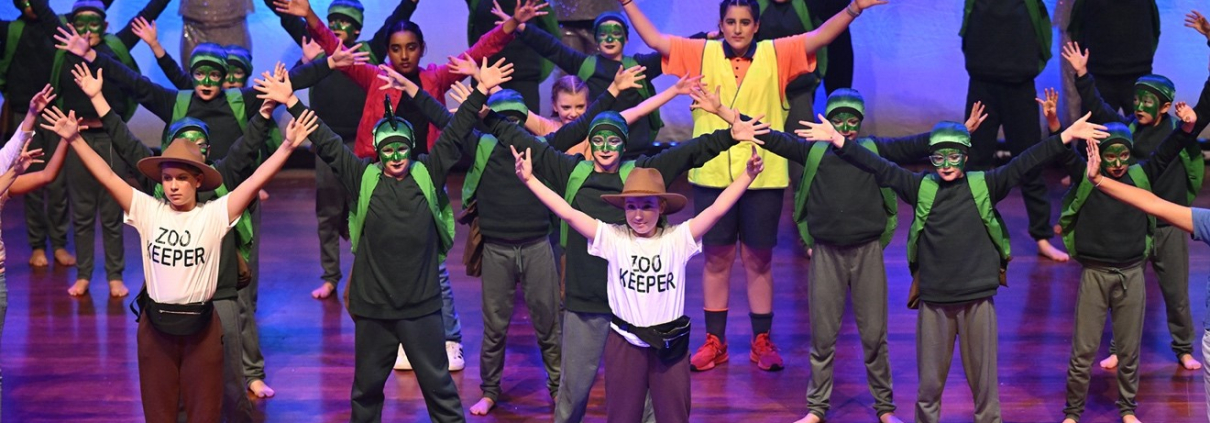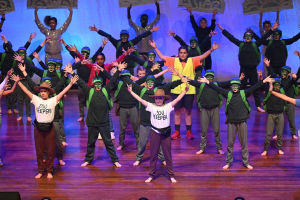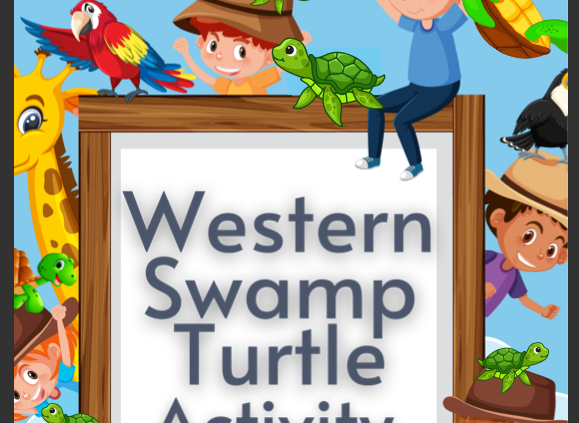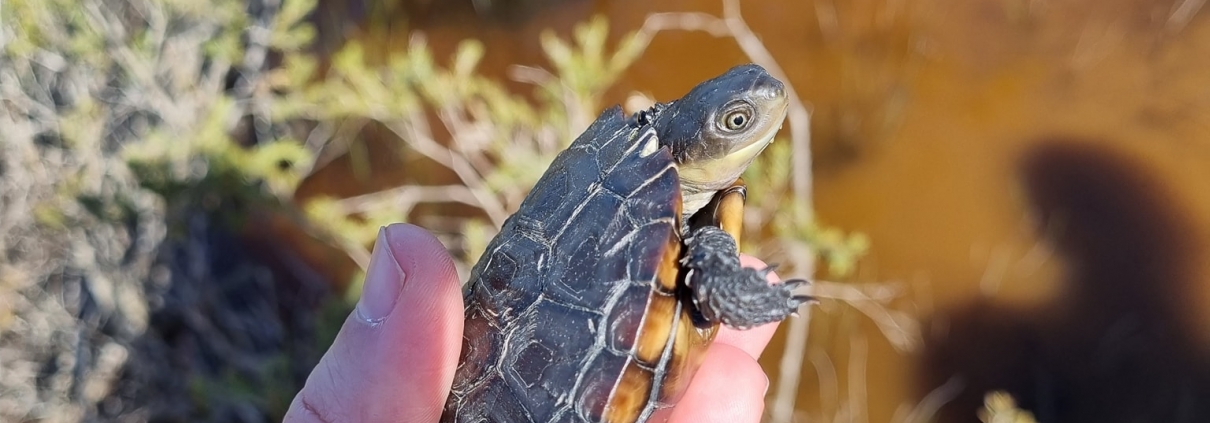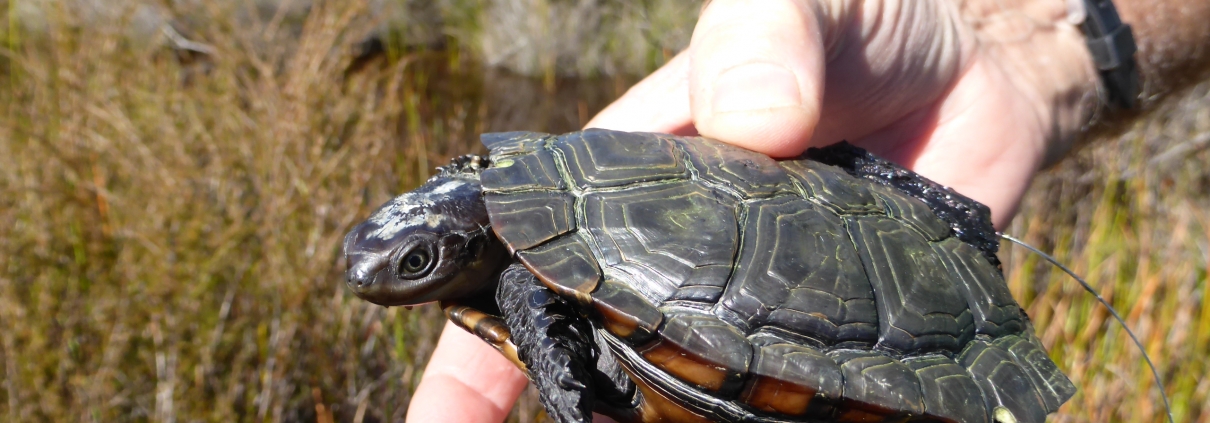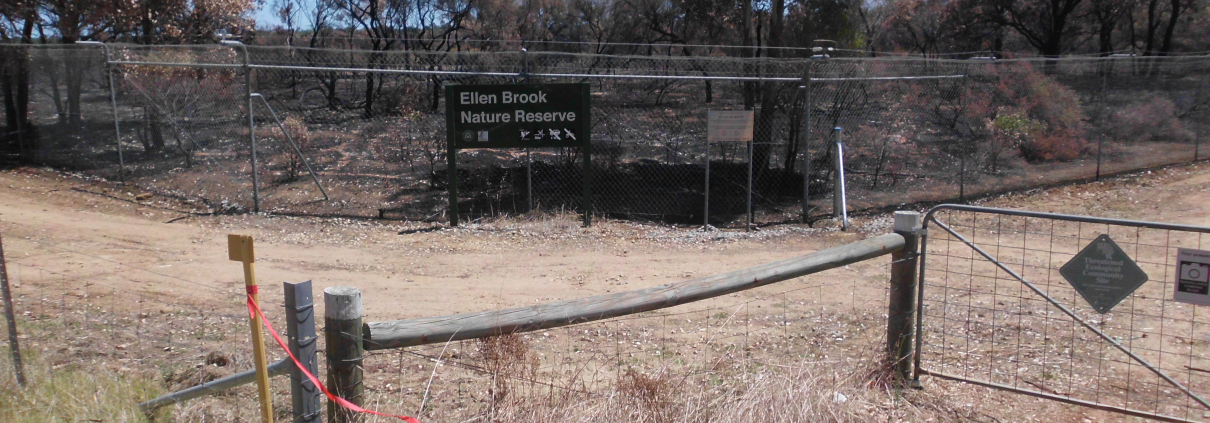Education team: Q&A time with Gooseberry Hill Primary School students
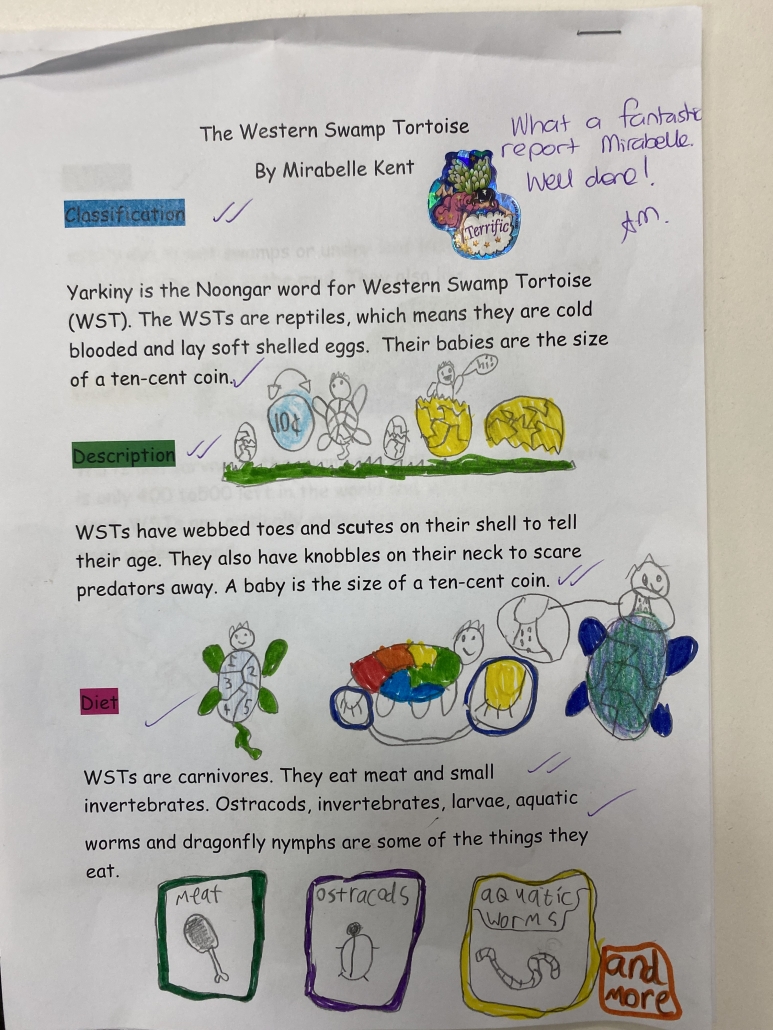
Learning about the WST with the Year 5 students. Cathy Levett took questions from the children and grouped them according to topic, then answered them as follows.
Q: How fast do they move? How fast are they in the water / on land?
Not very fast on land but when they get to the water they can quickly swim into the plants and disappear.
Western Swamp Tortoises are reptiles so they are ectothermic (cold blooded). This means that they need to bask in the sun and warm up so they can move a bit faster.
Q: How big do they grow?
A newly hatched WST is 2.4 – 2.9cm and 3.2 – 6.6g
WST are unusual because the adult males grow to be bigger and heavier than the female.
Males – up to 15.5 cm and 550g
Females – up to 13.5 cm and 410g
Q: Can you explain how their shell gets bigger?
The shell of the WST is part of the skeleton and so it grows as the skeleton grows. The scutes on the shell peel away to make way for larger scutes.
The parts of the shell are called:
CARAPACE – the hard upper shell
PLASTRON – flat lower part of the shell
Q: What do they eat?
Information on Gooseberry Hill Research page by the children
Diet (what they eat and drink)
Carnivores that eat small invertebrates; tadpoles, mosquito lavae, frogs, dragonfly nymphs, ostracods, beetle larvae, damselfly larvae, worms.
Q: Why do they live in one place? Why don’t they stay in the water for long?
WST have special needs for where they live. They live in and near ephemeral swamps which are wet in winter and dry in summer. They have clay or sand over clay soils. When the swamp dries out the tortoises move away from the swamp area and go underground until the swamps fill with water and food again. They do this so that they can survive without food through all of the dry months.
Q: Aestivation: How does it feel when they are aestivating? How do they live underground? How will they breathe when they aestivate?
While they are aestivating, it is like they are in a very deep sleep and their breathing slows down. Although they are underground, they get air from the spaces between the soil particles.
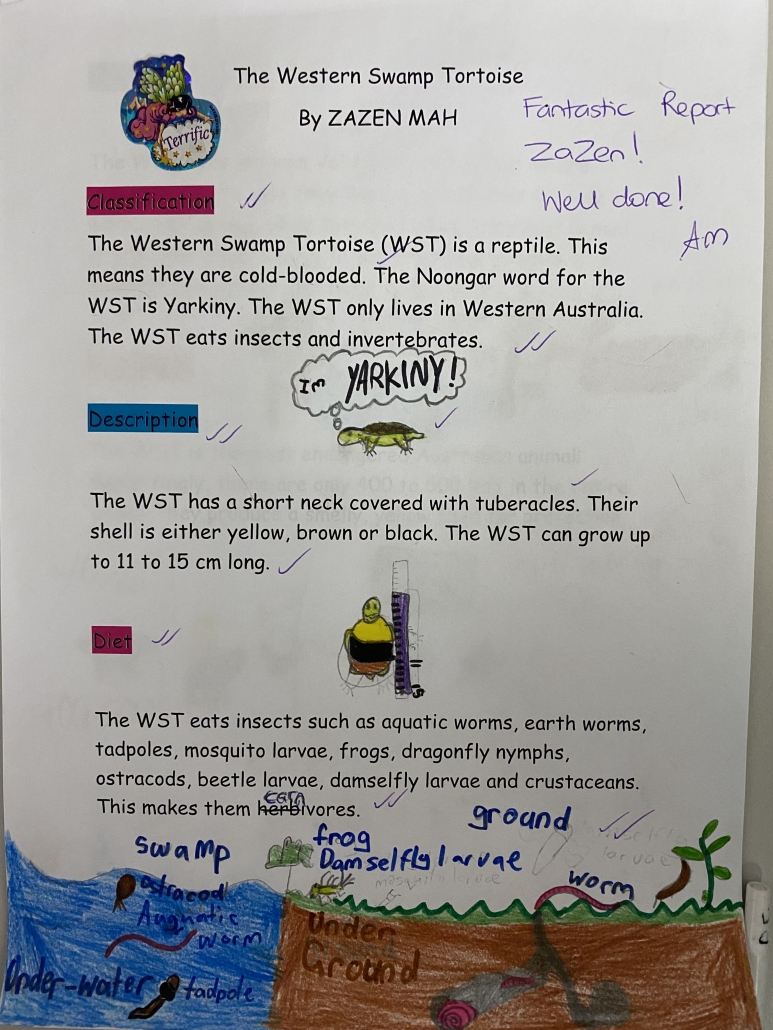
Chairperson’s report, 2022
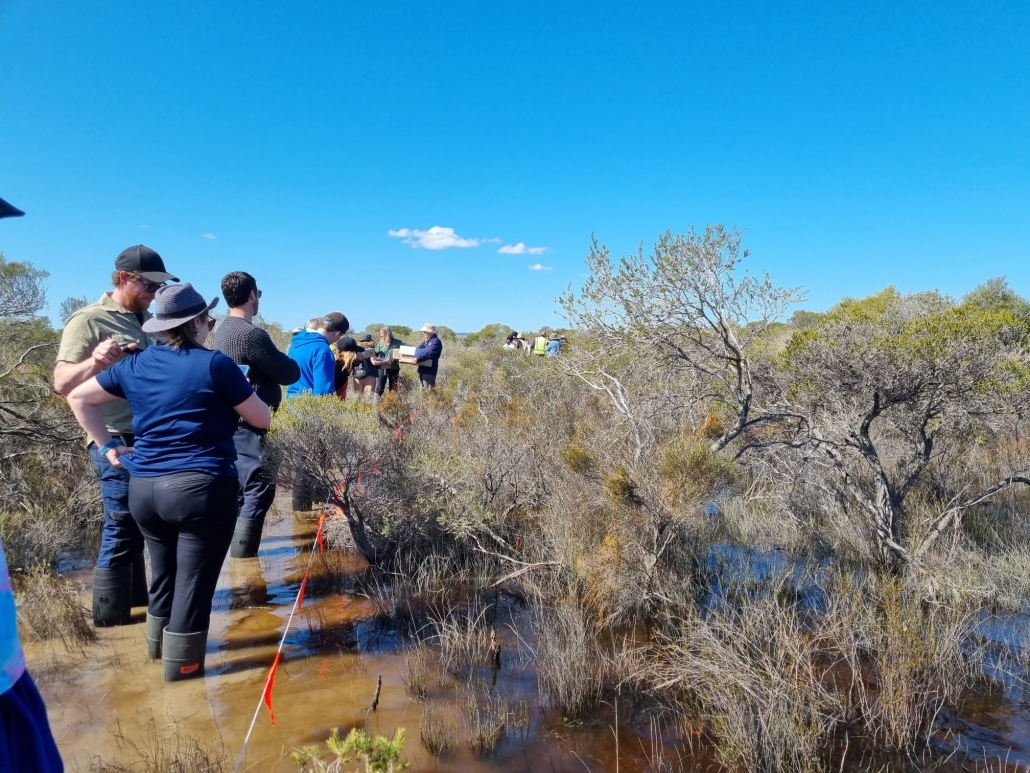
- On the 31st of August, 147 tortoises were released at Moore River NP. There were over 70 participants, many new members of the group. A further 40 tortoises were released down at Scott River NP.
- An e-news bulletin has been initiated as the committee is keen to involve people all over WA in the work we do. It is distributed to 600 members every month (we are up from 400 members this time last year). So far it has been sent out in May, June, July, August, and September. Thank you to Tanya and key2creative for their help.
- Tortoises Tales newsletter is still to be edited by Tanya and released 3 times per year with more in-depth information. 1000 hard copies are printed and distributed to libraries, schools, and businesses in the Swan Valley.
- Claire has been keeping the Facebook page up to date, helping us to keep in touch with a wider audience. We have had several overseas queries, including one from Prague Zoo asking to use some of our photos.
- We presented a successful submission to the City of Swan councillors opposing amendments to the buffer zone of the nature reserves, and we are keeping a close eye on the Kingsford estate in Bullsbrook and the proposed Vines redevelopment.
- There was a walk along Ellen Brook at Clementine Estate led by Claire and Cathy after the May FoWST meeting.
- The July meeting was at the Margaret River Chocolate Company, where we viewed the sculpture commissioned in 2019.
- Jo Perry from Dormilona Winery has once again been our major sponsor in 2022. She has moved to a new venue in Margaret River with a cellar door, so we were pleased to be able to design and produce a sponsorship sign to go on the building.
- Over 2000 volunteer hours have been recorded at DBCA by the FoWST group.
- Cathy Levett spoke about involvement of young people, including the books All Because I Crossed the Road by Rachel Wu and Wally’s Way Home by Neeve Blackham-Jennings; also the Western Swamp Turtle Activity Book by Jennifer Wilcox (Year 5). There was a workshop at Clementine Estate for home schooled children.
- Cathy’s tortoise model is at the museum being repaired. Jan’s was also broken but was easily repaired.
- Jan called on members for help with various aspects of running the group, e.g. Mailchimp, Facebook, running stalls at events.
Community Engagement & Education – Cathy Levett
- Following the May meeting at Clementine Estate our education team were asked by the Swan Home School Community to run some activities. On the 16th of June Cathy presented workshops at Clementine for Early childhood, Primary and Secondary groups. The secondary school activities focused on the impact of development on the Western Swamp Tortoise and the broader natural environment. One of the young people, Sophie, was motivated to write a letter outlining her ideas for working with developers in educating future residents.
- We have been contacted by young people who have shared books that they’ve created about the WST. Neeve Blackham-Jennings wrote and illustrated Wally’s Way Home. It is available to buy through our group and the WA Naturalist Club. Jennifer Wilcox, a year 5 student, sent us the activity book she created, which we will be sharing via the website and Facebook. We have previously featured All Because I Crossed the Road by Rachael Wu, who was in attendance at the AGM.
- Jan and Cathy continue to visit schools for education sessions and following a recent talk at Gooseberry Hill Primary School, Cathy received reports written by Year 2 students. Samples were presented at the meeting.
- Karen Schmidt, a FoWST member, creates videos featuring WA nature on her “Life in the Bush” website. She is currently working on her Western Swamp Tortoise video with Neeve and Cathy. The video will help the education team to promote our books, resources and activities.
Kids creating their own books about the WST
With the encouragement of educator Cathy Levett (Vice-chair of the Friends group), Year 5 student Jennifer Wilcox recently sent us the activity book she created, which we will be sharing via the website and Facebook.
We’ve previously featured All Because I Crossed the Road by student Rachael Wu. Another student, Neeve Blackham-Jennings, also wrote and illustrated the award-winning Wally’s Way Home, which is available to buy through our website and also the WA Naturalists’ Club. Cathy is very pleased to be able to mentor these young authors.
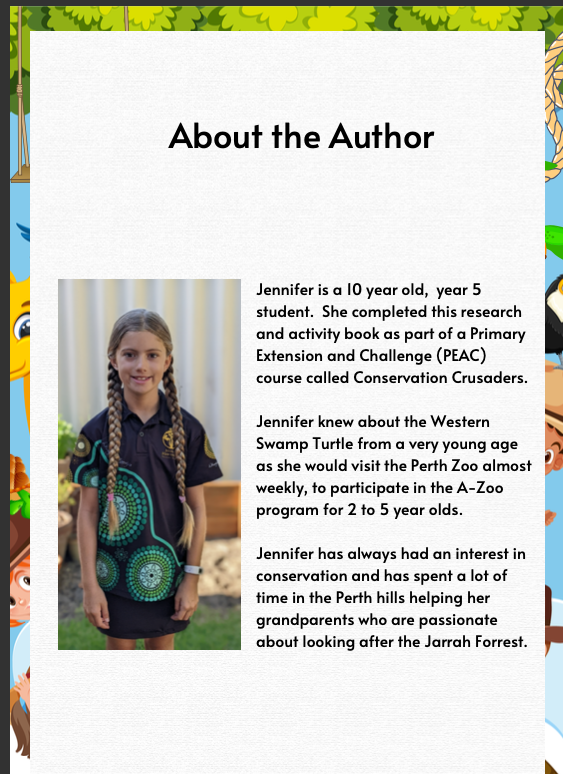
Tortoise Tales #33 (2022)
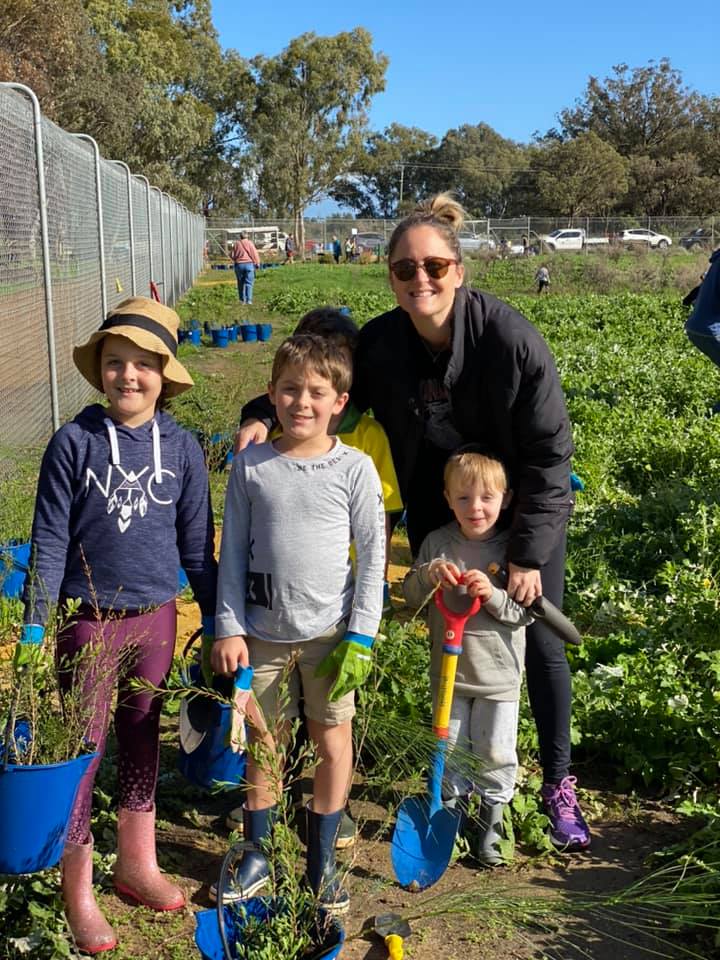
The latest news from the Friends group is now available here
Western Swamp Tortoises on the move
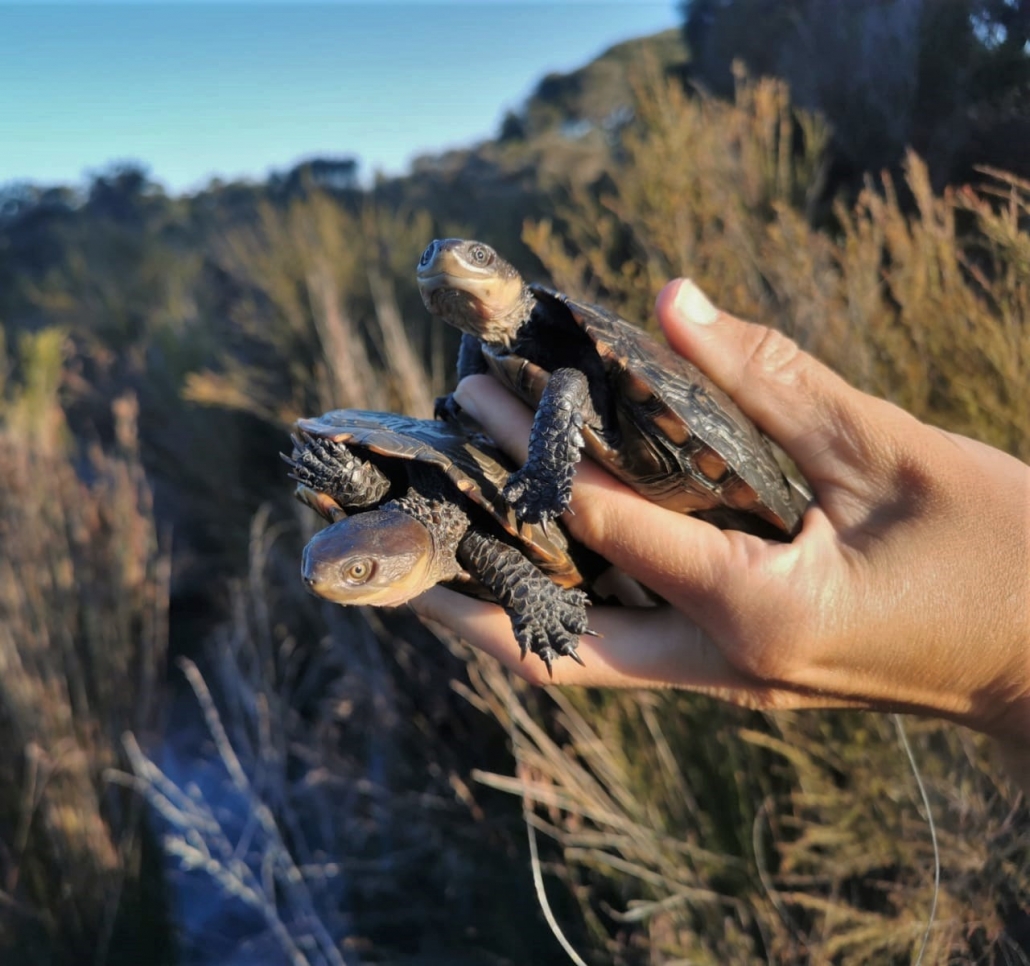
In addition to losing much of their habitat on the Swan Coastal Plain, our tortoises face the additional threat of climate change, as the seasonal swamps they inhabit will hold water for increasingly shorter periods of time. Recovery of the western swamp tortoise depends on securing and drought-proofing high-quality habitat in their indigenous range (in particular in and around Ellen Brook NR) and exploring new conservation options that account for future climate change.
One of these options is assisted colonisation – the intentional translocation of species outside their indigenous range to mitigate a threat – and has been explored as an option for the swamp tortoise by a team at the University of Western Australia (UWA) for over a decade. Assisted colonisation trials to wetlands near the south coast began in 2016, with juveniles bred at The Perth Zoo. These southern wetlands have longer hydroperiods than those near Perth, but are also cooler, and are expected to offer ideal microclimates for western swamp tortoises in about 20 years. Juveniles fared particularly well in a small trial wetland near the township of East Augusta, and grew comparable amounts to those released at Moore River National Park in the same year. See the full story here
Protecting habitat in City of Swan
Protecting habitat in City of Swan
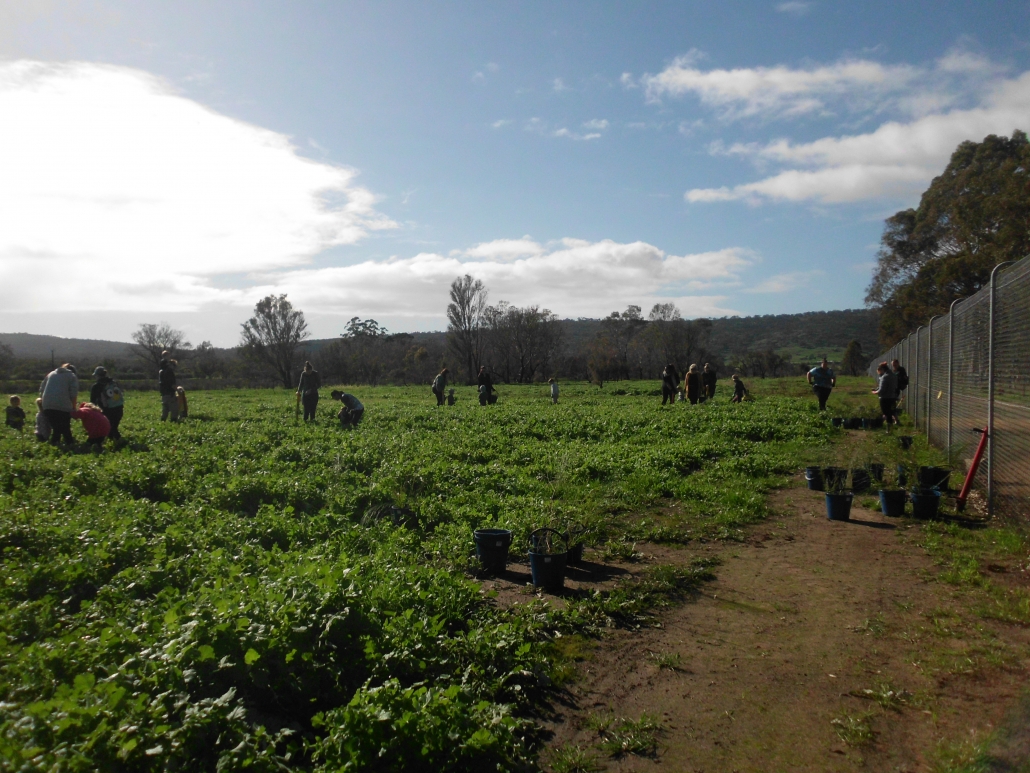
The Friends of the Western Swamp Tortoise became aware of an Amendment (132) to be presented to the City of Swan late last year concerning Ellen Brook and Twin Swamps Nature Reserves.
Our Chairperson, Jan Bant, addressed the Councillors at an Agenda meeting on 10 November 2021, speaking on the impact likely if the buffer zones were changed. The situation became critical after 5th February 2021, when 90% of the Ellen Brook NR, habitat of the last truly self-sustaining population of the tortoises, was burned. Most areas were totally burnt out, including our restorative revegetation plantings, and only black ash remained.
Any potential development in the buffer zones (the Amendment proposed modifying the minimum lot size from 8ha to 2ha) would have had a detrimental impact on the area.
See how things turned out here
Good news on National Threatened Species Day
September 7 is National Threatened Species Day, and we’d like to highlight a good news story for our little friend, the western swamp tortoise. In addition to losing much of their habitat on the Swan Coastal Plain, tortoises face the additional threat of climate change, as the seasonal swamps they inhabit will hold water for increasingly shorter periods of time. Recovery of the western swamp tortoise depends on securing and drought-proofing high-quality habitat in their indigenous range, and exploring new conservation options that account for future climate change.
Assisted colonisation is the intentional translocation of species outside their indigenous range to mitigate a threat, and has been explored as an option for the tortoise by researchers from the University of Western Australia (UWA) for over a decade. Assisted colonisation trials to measure growth rates of tortoises in cooler climates began in 2016, with juveniles bred at the Perth Zoo released to two locations ~ 300 km south of Perth. These southern wetlands were cooler and had longer hydro-periods than those near Perth, and were expected to offer ideal micro-climates for western swamp tortoises in about 20 years. Juveniles fared particularly well in one of the southern wetlands near the small township of East Augusta, and grew comparable amounts to those released at warmer translocation sites, such as at Moore River. It is thought that the good growth was achieved partly due to the abundance of aquatic food resources such as tadpoles, and longer wet periods resulting in longer times for foraging. A second assisted colonisation trial in 2018-19 revealed that bio-tags attached to tortoises could help researchers reconstruct how tortoises behaved in different climates – and in particular, to identify the weather conditions that allowed them to be active.
A third assisted colonisation trial has just commenced in the East Augusta region in August 2021, with the objective of understanding whether the energy requirements of the species can be met in cooler climates, over both the short- and long-term. More than 70 tortoises bred at Perth Zoo were released, and most are carrying small tags that record their activity and shell temperature. If the trial is successful, the tortoises may have a new area to call home, and one that could safeguard the species as the climate changes. The research at East Augusta is being led by UWA researchers (primarily PhD candidate Bethany Nordstrom), with the support of many staff at the Dept of Biodiversity Conservation & Attractions and the Western Swamp Tortoise Recovery Team. The Friends of the Western Swamp Tortoise have purchased some of the bio-tags and monitoring equipment for the year-long trial, for which the research team members are very grateful!
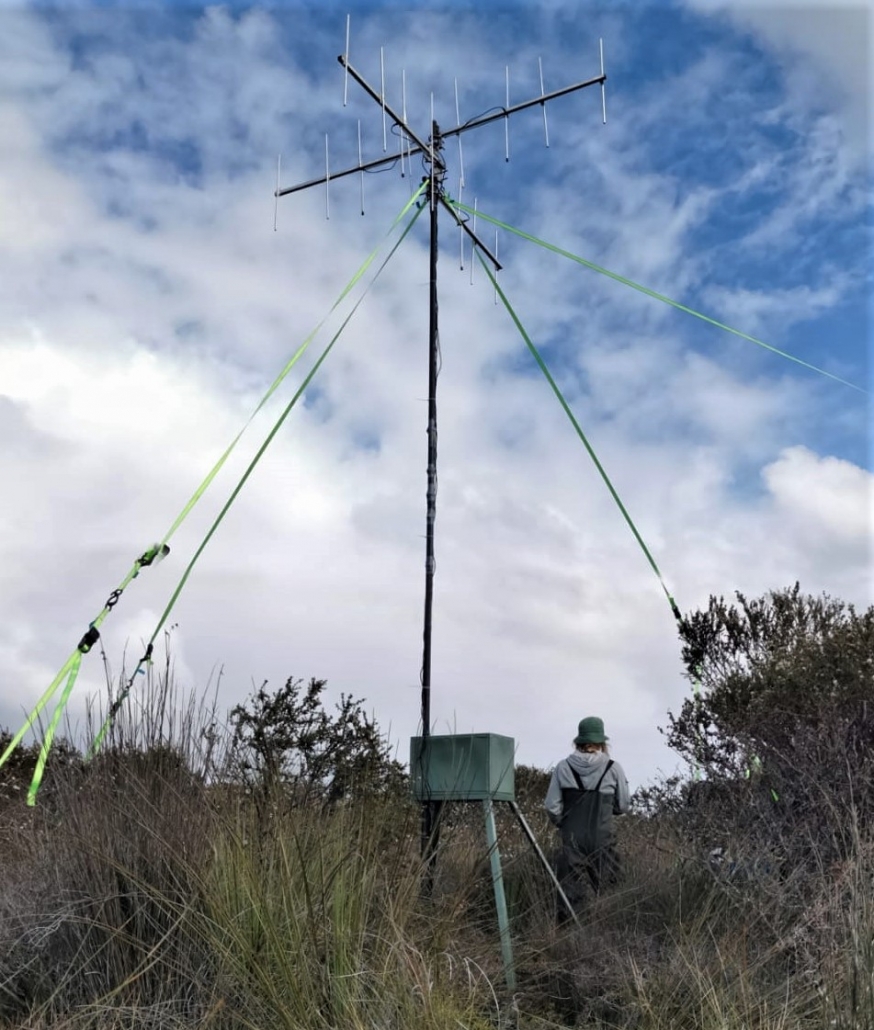
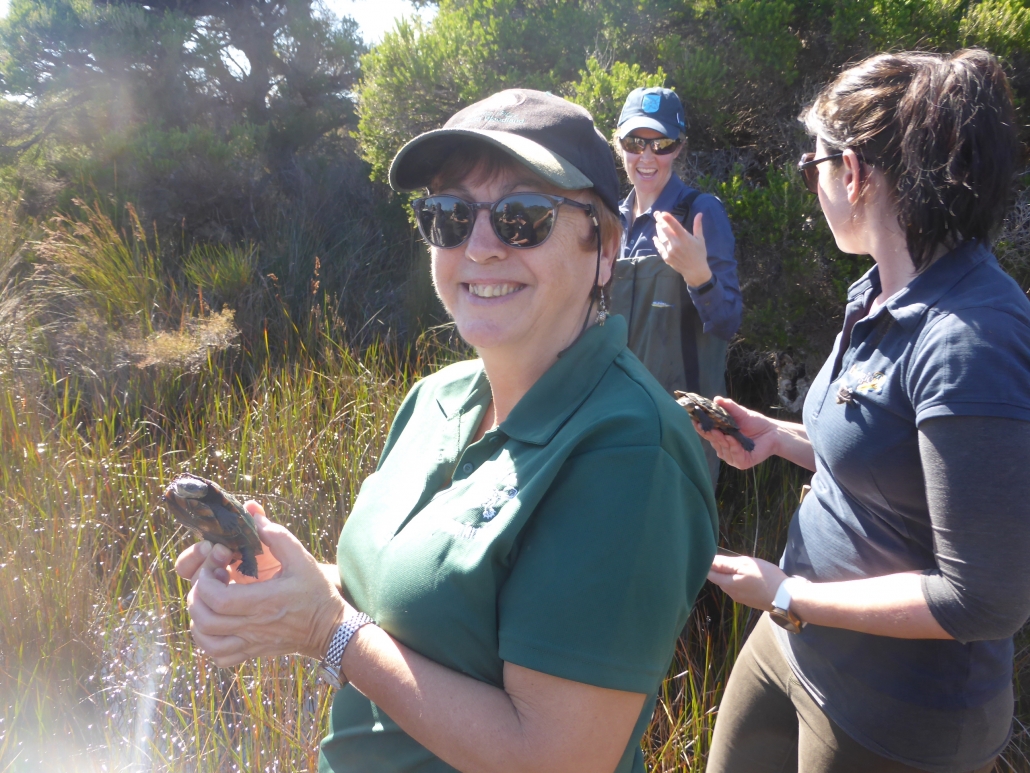
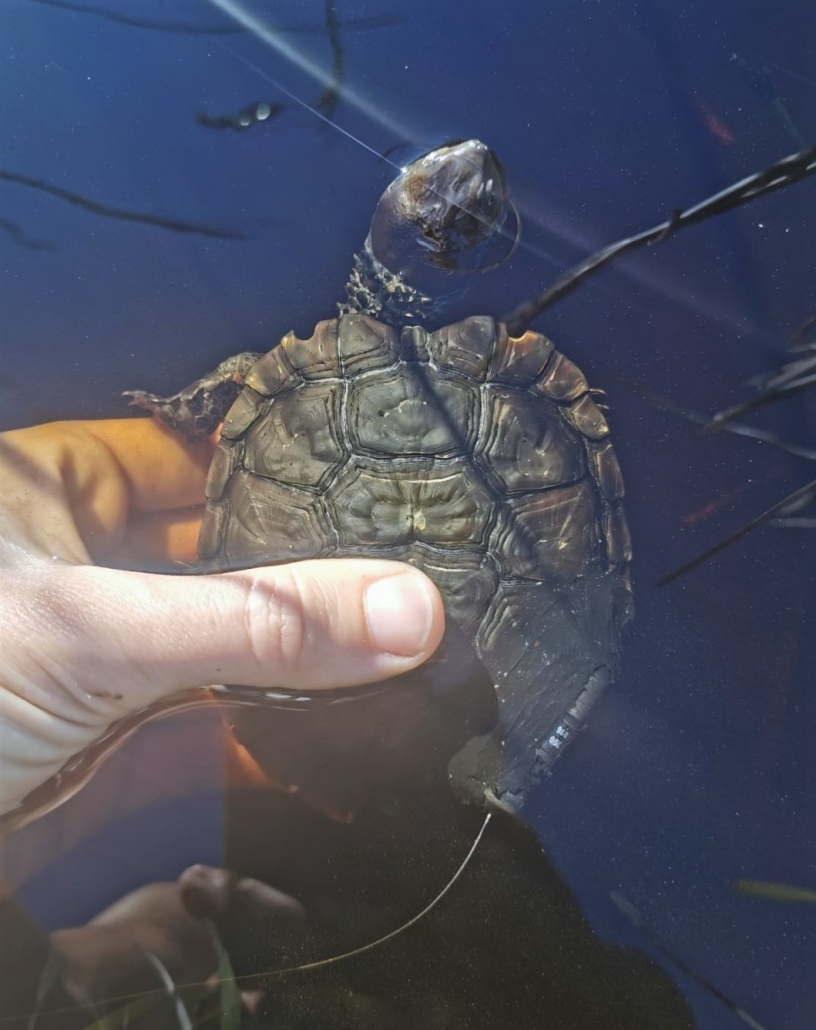
Tortoise Tales # 32 (2021)
In this edition of the newsletter we tell you about the devastating bushfire at Ellen Brook NR in February and how you can help us begin to rectify the damage. We also talk about the role of ‘conservation dogs’.
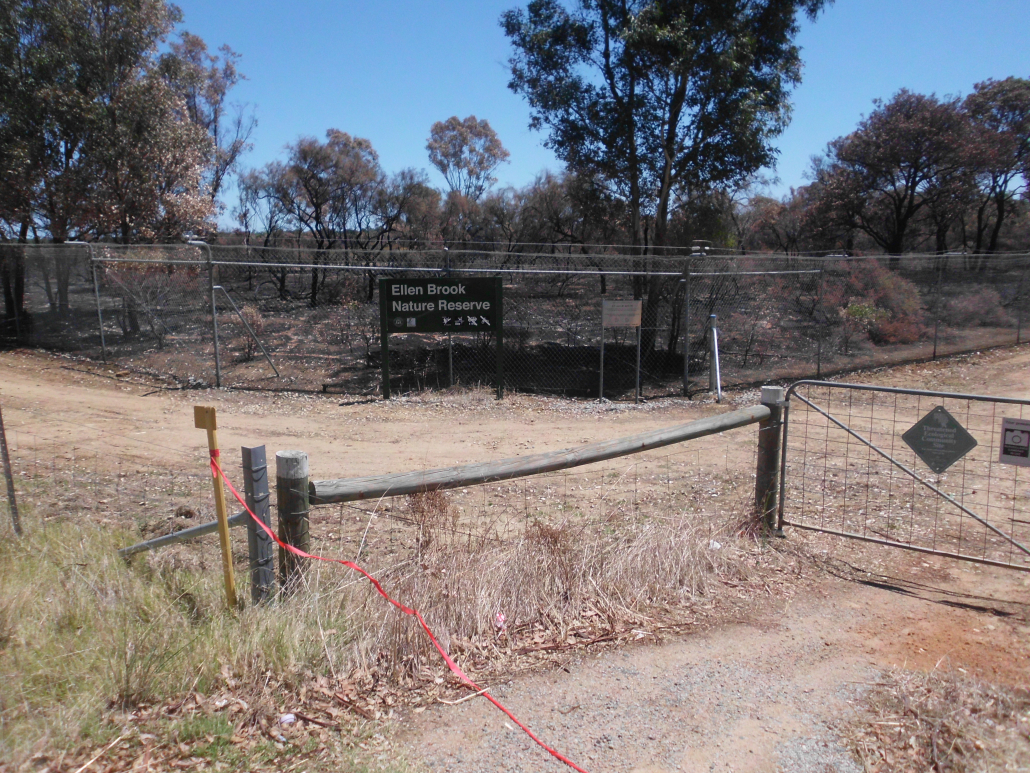
Click here to download a PDF of this newsletter.

